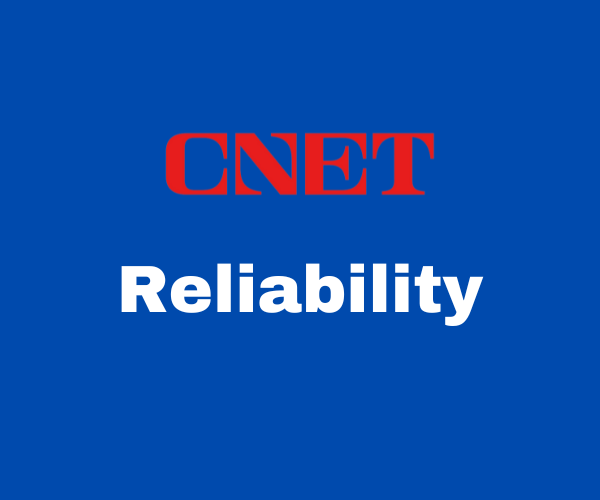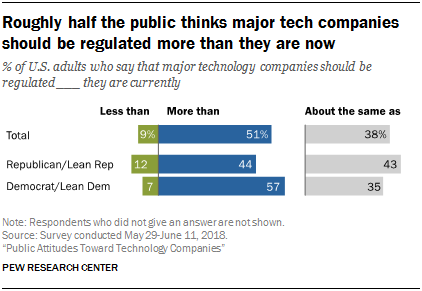
Considering its elite reputation for technology, CNET reports “Our experts give you news, tools and advice that help you navigate our ever-changing world. Because when you understand what’s going on, you can do something about it.”
Pew Research finds that relatively few Americans trust major technology companies to consistently do what is right.

Source: Pew Research
Biasy evaluates the reliability and accuracy of all media outlets. This article in specific will investigate the accuracy of CNET Media and their articles.
Does Reliability Matter?
Reliability, in general, refers to how trustworthy or accurate information, or in this case, a news source is. If we consider this definition, it quickly becomes clear why reliability is important in media sources. If we can’t trust the things we read then there isn’t much of a point in continuing to consume content from that source, after all. So how exactly can we gauge the reliability of a news source anyways?
There are several potential measures of reliability to look out for when trying to determine whether a media source is reliable or not. Red flags for an unreliable article can include the presence of wild unsubstantiated claims, facts dependent on other unreliable sources, heavy use of opinionated language, and more. Some indicators of a reliable news source, on the other hand, include things like:
- Absence of subjective/opinionated language in articles
- Credible sources cited (e.g., neutral sources, .gov, .edu websites)
- Facts and statistics backed by multiple relevant outside sources
- Use of primary sources when possible (e.g., interviews, quotes)
- Information that remains consistent across news sources
So How Does CNET Media Fare in its Reliability?
The political reliability index developed by Biasly objectively assesses news organizations’ accuracy and trustworthiness. CNET’s overall Reliability Score has been rated as ‘Fair’ by Biasly. This rating is a weighted average of two distinct scores: the Fact Analysis Score and the Source Analysis Score, each evaluating separate components of CNET’s Reliability. When computing the Average Reliability of the article the Fact Analysis score is more heavily weighted. These ratings are as follows in the next two paragraphs:
CNET’s Fact Analysis Score is ‘Poor,’ which suggests readers can trust few of CNET’s content online. The Fact Analysis score focuses more on the accuracy of claims, facts, and sources presented in the article and any hints of selection and omission bias, which we will discuss further in the article.
CNET’s Source Analysis Score is ‘Fair,’ which suggests readers can trust some of the sources, links, and quotes provided by the news source. This score, which is based on A.I., focuses on assessing the quality of sources and quotes used including their number, lengths, uniqueness, and diversity.
However, since these scores are based on percentages and averages, individual articles could be more or less trustworthy depending on the context, author, and other factors. Our findings show that CNET’s reliability is mostly but not all factual because they have retracted several stories in the past or had pieces that were not factual.
Let us analyze the supporting data for CNET’s rankings and discuss what to watch out for while searching for trustworthy news sources.
CNET Media Accuracy and Reliability
The accuracy and reliability of news organizations are significantly impacted by bias and political orientation. By evaluating CNET Media’s integrity and deducing how well they support claims with evidence, we will be able to determine their dependability. We will also check for selection and omission bias to assess the articles’ factuality.
Selection bias is when stories and facts are selected or deselected, often on ideological grounds, to create a narrative in support of the new sources’ ideology. Omission bias, on the other hand, is when different opinions and political views regarding a situation are left out so that the reader is only exposed to the ideological perspective supported by the author. It’s important to keep in mind these two types of biases when trying to assess an article’s level of accuracy.
Biasly aligns a percentage score for accuracy, ranging from 1 (least accurate) to 100 (most accurate.) These ratings are calculated based on several factors: how well claims are supported with evidence, the number of reliable internal sources that are used as well as external sources. A full page on Biasly’s website includes credibility and reliability ratings for CNET Media articles.
Recall that Biasly has given this source an excellent reliability score, although it is important to note that this score can vary from article to article– with most extreme variations in dependability coming from selection and omission bias.
Consider also another Central news source, BBC, which is rated 77% according to Biasly. They had one article that was 90% reliable titled “Abortion rights: US Catholic bishops face clash with Biden” and another article rated only 52% reliable, titled “Biden: Georgia voting restriction law is ‘atrocity.’” Resultantly, stories displaying heavy political leaning are less reliable than neutral ones.
Further, this CNET Media article titled “Tiktok CEO to Face Congress, Say It Has Solutions to Data Concerns” is rated as Center, meaning that it does not fall to one side of the political spectrum or the other.
Authors Carrie Milhalcik and Meara Isenberg use multiple and unique sources and quotes from both sides in this article to capture a holistic view of the issue. As such, one could argue that the authors avoid selection and omission bias as there is no indication of a political leaning or the omission of one side– rather, all parties are given equal length. For example,
“Officials are concerned US user data could be passed on to the Chinese government or that the Chinese government could dictate what content is shown on TikTok in a bid to influence public opinion in the US.”
“‘Tiktok has never shared, or received a request to share, U.S. user data with the Chinese government,” Chew will say, according to the prepared remarks. ‘Nor would Tiktok honor a request if one were ever made.’”
Avoiding emotionally loaded language and preventing the use of selection and omission bias is critical to achieving the most reliable news.
We will take a closer look at more articles and provide a further investigation into their reliability. This will include the use of selection bias, omission bias, and quality of sources and facts used.
Analysis of Reliability in CNET Media Articles
While opinion-style journalism gives reporters an outlet to express their personal views, excessive opinions are something that news outlets typically want to avoid in general news articles. Consider also that opinion pieces are less trustworthy because they are subjective, but still offer a different political perspective.
CNET Media has no record or indications of misinformation or failed fact-checks– something that would be an immediate red flag for determining reliability.
Quality of Sources and Facts Used
CNET Media can be good at using reliable sources from both sides of the ideological divide, considering that their media bias score is Center. Consider this article, titled “US trade agency bans imports of some Google devices in Sonos patent fight.” Author Steven Musil in his short article uses three quotes, one being short and two medium. Further, he utilizes four sources, listed below:
- US International Trade Commission
- Past CNET Media articles
- Sonos
- Google spokesperson Jose Castaneda
While the quality of sources is ample to cover the topic at hand, including both parties in the patent fight and consulting the US International Trade Commission and their documents, it is safe to say that CNET Media provides a holistic view of the issue as well as consulting both sides of the story in an objective article piece.
Here’s an example of a neutral quote that focuses on reporting without political bias used as follows:
“Google’s patent battle with Sonos comes as the search giant faces intense scrutiny from federal and state officials over its size and competitive practices. The search engine giant is the target of several major antitrust lawsuits, including a landmark case involving the US Department of Justice, and two complaints from bipartisan coalitions of states.”
Selection and Omission Bias
Another example is from CNET Media, where the author portrays an opinion surrounding the January 6th insurrection. As such, this article titled “Jan. 6 Capitol Hill riot forces social networks to look at their ugly side,” takes a deep dive into social networks such as Facebook and Twitter for scrutiny faced on how they police political misinformation.
The author consults ProPublica and The Washington Post, determining that Facebook played a critical role in spreading misinformation and lies leading up to January 6th.
“At least 650,000 posts in Facebook groups attacked the legitimacy of Joe Biden’s presidential victory over Donald Trump and many called for political violence.”
The author does seek to address both political parties, mentioning Trump and Biden with their respective claims. The article mentions:
“Trump and his supporters continue to peddle unfounded claims on social networks that the election was stolen from him.”
Meanwhile, the author also addresses the Biden administration and their opinion on the “brutal attack” from two years ago.
Addressing the presence of selection and omission bias, one could argue that there is an effort to create a narrative in support of the Biden administration and against Trump and his supporters. Provided that the election has been proven not to be stolen, this also indicates that the author is trying to be fair in their reporting with outstanding facts and is not picking a side. However, they must continue to navigate down a neutral path without picking sides.
Similarly, the author gives space for differing opinions and political views, however again one can argue that the reader is being exposed to the ideological perspective of the author, which is the position that social networks need to find a solution to limit misinformation on their platforms– as well as the spread of misinformation leading the Jan. 6 attack.
While opinion pieces offer plenty of room for expression, they also have the potential to lead to issues with factuality, sources, and selection and omission bias. The articles that we’ve covered so far have not had a significant bias in them, which affirms Biasly’s center-right leaning media bias rating that it gave to CNET Media. Accordingly, one can argue that their pieces are also, for the most part, reliable, given that no failed fact checks have occurred and no severe occurrences of selection and omission bias are present in their articles.
Consider also that as a news organization with a central political position, they have the incentive to continue to appeal to either both moderate sides of the spectrum or simply those who find themself in the middle. Now that we’ve addressed these topics surrounding reliability and factuality in articles, it will help to stay current and informed on the most accurate news.
So Is CNET Media Reliable?
As a result, it can be argued that most of CNET Media’s material is reliable. With this being said, the more you research media reliability and accuracy, the easier it will be to spot problems with sourcing, omission and selection bias, and other factors that affect reliability. A critical source in combating this is Biasly’s News Bias Checker, to help uncover these reliability issues and help you find the most accurate and dependable news.






















